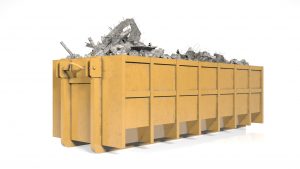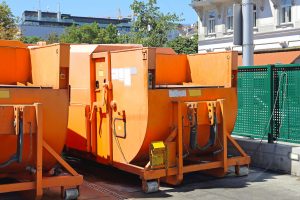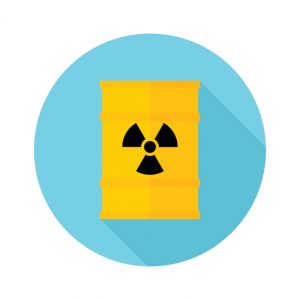by CharlieB | Jan 12, 2017
 If someone were to ask you how much you spend on trash disposal for your home, would you know the answer? Perhaps you do, because for most of us that cost is around $10 to $40 per month, or a couple hundred per year. At that low price, you can see how one might take waste collection for granted. It’s far too easy to get into a routine of leaving the garbage out on the curb for someone else to handle. I can certainly say that I’ve let it slip my mind!
If someone were to ask you how much you spend on trash disposal for your home, would you know the answer? Perhaps you do, because for most of us that cost is around $10 to $40 per month, or a couple hundred per year. At that low price, you can see how one might take waste collection for granted. It’s far too easy to get into a routine of leaving the garbage out on the curb for someone else to handle. I can certainly say that I’ve let it slip my mind!
Well business and manufacturing plant owners don’t really get that luxury. Trash disposal and handling is integrated into their yearly budget. Far from a couple hundred, they are usually paying upwards of $900 depending on their location. Suddenly it’s not so easy to let trash disposal slip your mind, is it? KenBay understands that plight and want to help! If you are looking to increase savings without sacrificing your environmental integrity, this week’s blog is for you. Here are some great ways to cut costs out of industrial trash disposal.
How Much Does Your Trash Cost?
Besides the average cost of living in your location, there are actually a lot of contributing factors to the cost of your waste management. Some key ones include the volume of the waste as well as the specific types you are getting rid of. Certain materials are more difficult to dispose of than others. Other factors include the cost of manpower, fuel for the trucks, and the number of trips between the dump and your factory. Add it all together and it’s no wonder that garbage gets so costly over time!
Good News for Your Trash Disposal
You may be sweating, considering how many small factors could end up contributing to such a big debt. But here is the good news: you can control almost all of the ones I just mentioned! The best way to reduce your trash volume is, of course, reusing and recycling. You aren’t hauling what doesn’t need to be thrown out, after all. As to the other factors, we here at KenBay can offer some assistance with them!
See, a KenBay RotoPac is ideal for compacting your waste because it is small and has a high level of compaction. Its size means that it is more portable than a regular compactor, and can be used right at the source of your waste! This means less handling and less money spent towards manpower. Additionally, a KenBay RotoPac continually presses all your waste into tight airless cubes. These cubes are more stackable, and allow you to fill up more of the truck. Remember, you are paying for volume, not weight! The less of that volume is filled with air, the more money you are saving. This in turn saves money on fuel, since you are making fewer trips!
If you think a KenBay RotoPac is the trash disposal answer you’ve been looking for, then check out our website. We have a wide selection of RotoPacs to fit any waste need. You can try a RotoPac before you choose to buy it, and we will send it to your site. If you like it, simply pay to keep the one we already sent you! Start seeing the savings, with KenBay!
by CharlieB | Oct 28, 2016

They say that necessity is the mother of invention. Every great, long-lasting improvement in technology came about because there was a need for it. We needed faster ways of transportation, so the car was invented. Drivers couldn’t see in the rain, so windshield wipers were devised. All throughout history are examples of ingenuity rising up to solve a problem. Well, one modern day problem for plant workers is how to properly get rid of waste like label matrix trim. It needs to be disposed of, and there are a many machines built just for that purpose. But trim removal systems can occasionally jam if running too quickly, and clogged machines mean wasted time and money. Plant personnel have gotten very creative when it comes to dealing with label matrix disposal. Everything from shredding to actually devising ways to use it in the machine itself. We here at KenBay have a better idea: don’t deal with it at all! Simply throw the label matrix directly into a continuous compactor at the source of the waste. Just bag it and dump it!
Why a Continuous Compactor?
You’re probably familiar with a traditional trash compactor. They’re large, they smell bad, and they are normally triggered by opening and closing the door three times. If your plant is already using one, why is a continuous compactor better?
For one thing, a continuous compactor never needs to be manually switched on. It’s right there in the name, continuous. It never shuts off on its own! A constantly rotating arm keep pressing down whatever you throw into it into neat and tidy and stackable cubes. The shape of these cubes is another great thing about continuous compactors — you’re never paying to haul around any unnecessary air when you’re getting rid of your waste. Just stack the cubes up and fill more space on the junk hauler!
Another issue is safety. We mentioned that traditional compactors are big, right? Often they’re so large that they’re immovable without additional machinery. Once you set them down, they’re not going anywhere. What does this mean for you and your employees? It means that whenever you have something like a label matrix that you need to trash, you need to leave your station and move there physically. I don’t need to tell you the risk of walking around an area with heavy active machinery! Smaller continuous compactors can be placed right at the worksite, so you can just toss the label matrix trim in when you need to and continue on with the work. In short, it helps to reduce unnecessary risk.
KenBay Helps You Manage Label Matrix Disposal
KenBay has a wide variety of inexpensive continuous compactors that are portable and easy to handle. Because they have a small footprint, it is easy to have multiple compactors at key waste disposal sites. Our line of products not only offer a safer solution to waste disposal, they are efficient as well. You won’t squander unnecessary time disposing of your waste, and you won’t pay extra money to haul air to the landfill. If you are interested in having a continuous compactor for your plant, contact us to try it before you buy it. Discover the difference the right compactor can make!
by charlotte | May 20, 2016

Paint disposal or storage can be a daunting task whether you’re dealing with a small home supply or an industrial facility with various paints and solvents to consider. With just a few protocols, you can be sure that your paint disposal is always safe and environmentally sound, no matter the quantities you’re handling. Taking care of your paint disposal in the proper way will do more than just ensure the safe handling of hazardous waste, it will also save you money in long run, and reduce risk in either your workplace or home.
Reduce Your Need for Paint Disposal
Whether you’ve recently repainted your house, or work in the autobody business and go through gallons every day, proper paint disposal is equally important to consider. But before you get to that step, there are many measures you can take to reduce the amount of waste you have when the job is done. First, make sure that you can return any unopened paint cans or spray bottles. You will not only get reimbursed and save yourself some money, but it will also ensure that the paint actually gets used instead of thrown away. Safely store some of the leftover paint in a cool dark location for touch ups, and be sure it is tightly sealed. You can even switch it into smaller airtight containers to save space or get a better seal. Properly stored paints and solvents will usually remain safe to use for up to ten years, so give them a permanent home that is out of the reach of the kids. There are also ways of re-tinting paint to use it for new or different purposes than you originally bought it for.
Leftover Paint Disposal
If there is still paint or solvents (often used for cleaning) that you cannot repurpose or save for future use, you will need to find the proper means to dispose of them. These materials are usually considered liquid hazardous waste, so they cannot go in the dumpster. Call your local waste sector to find out how you ought to handle paint disposal, which will typically involve a certain kind of airtight container for paint. It will also have to be kept separate from the rest of your waste and recycling to ensure that contamination does not occur.
Solid Waste in Paint Disposal
A paint can or spray bottle is considered empty if it has less than one inch of paint at the bottom of it. Empty the vessel by either pouring or pumping the paint out of it, and once you have done this, it is considered recyclable, in which case you take the usual measures to separate it out from landfill waste. If paint cans are a significant portion of your waste, you might want to consider investing in a trash compactor that will help you consolidate the otherwise non-pliable materials to save time and money on your recycling efforts. A trash compactor will reduce the size of your waste at a rate of six to one.
When tackling your paint disposal process, keep these things in mind. If you’re dealing with paint disposal on a large scale, call KenBay for an expert opinion on your particular waste management needs.
by charlotte | Apr 13, 2016
 The hazardous waste disposal industry ships in excess of 3 billion tons of regulated materials throughout the United States each year. Hazardous waste disposal can seem a looming task in your operations, but with the right information and resources, it can be an easy, safe and worry-free process. There is no reason to be overwhelmed at the rules and regulations around hazardous waste disposal, or to put yourself and your employees in unsafe situations by neglecting to handle it with care. If you’re looking for new and better ways to take care of your hazardous waste disposal you’ve come to the right place as we are waste management experts and have all the information you need to make your workplace as safe and clean as possible.
The hazardous waste disposal industry ships in excess of 3 billion tons of regulated materials throughout the United States each year. Hazardous waste disposal can seem a looming task in your operations, but with the right information and resources, it can be an easy, safe and worry-free process. There is no reason to be overwhelmed at the rules and regulations around hazardous waste disposal, or to put yourself and your employees in unsafe situations by neglecting to handle it with care. If you’re looking for new and better ways to take care of your hazardous waste disposal you’ve come to the right place as we are waste management experts and have all the information you need to make your workplace as safe and clean as possible.
Hazardous Waste Disposal Packing Categories
The first thing you need to figure out is what packing categories your hazardous waste falls into. There are nine different classes that indicate the degree of danger of your hazardous waste. Because your hazardous waste will need to be removed from you worksite, the Department of Transportation has established guidelines for how your hazardous waste must be packaged for the safest transportation possible.
- Class 1 Explosives and pyrotechnics
- Class 2 Compressed, flammable, nonflammable, and poison gases
- Class 3 Flammable liquids
- Class 4 Flammable solids
- Class 5 Oxidizers and organic peroxides
- Class 6 Toxic and infectious materials
- Class 7 Radioactive materials
- Class 8 Corrosive materials
- Class 9 Miscellaneous dangerous substances and articles
The manner in which you store and package your hazardous waste is extremely important in order to be properly insured and as safe as possible. Find out which classes apply to your hazardous waste disposal and how you need to package all of the waste materials you are creating.
Hazardous Waste Compactors
If your hazardous waste falls into any of the solid waste classes, then a hazardous waste compactor could improve both your workflow and safety in your workplace. The HazPac for Hazardous Waste from KenBay is an excellent product capable of reducing the size of your hazardous waste while keeping it confined. Depending on the packing class of your waste, the HazPac can be customized to either package it into plastic bags or tri-wall waste boxes.
The Benefits of the HazPac
The Hazpac not only keeps your waste confined to a specific area, it also has an incredibly small footprint. This means that you can place it right at the site where your hazardous waste is created, cutting down not only on the time hazardous waste disposal takes, but also the distance it has to travel. The risks of contamination will decrease significantly. The HazPac can also contain six times as much hazardous waste as a conventional waste can, which will greatly decrease the packaging and removal costs.
Don’t take hazardous waste disposal lightly. It is a serious matter that requires a legal and thoughtful plan. There are many resources to help you make sure your hazardous waste disposal is as efficient and safe as possible, including waste management experts like KenBay. Give us a call to see how we can help you with your hazardous waste disposal plan.
 If someone were to ask you how much you spend on trash disposal for your home, would you know the answer? Perhaps you do, because for most of us that cost is around $10 to $40 per month, or a couple hundred per year. At that low price, you can see how one might take waste collection for granted. It’s far too easy to get into a routine of leaving the garbage out on the curb for someone else to handle. I can certainly say that I’ve let it slip my mind!
If someone were to ask you how much you spend on trash disposal for your home, would you know the answer? Perhaps you do, because for most of us that cost is around $10 to $40 per month, or a couple hundred per year. At that low price, you can see how one might take waste collection for granted. It’s far too easy to get into a routine of leaving the garbage out on the curb for someone else to handle. I can certainly say that I’ve let it slip my mind!



 The
The 